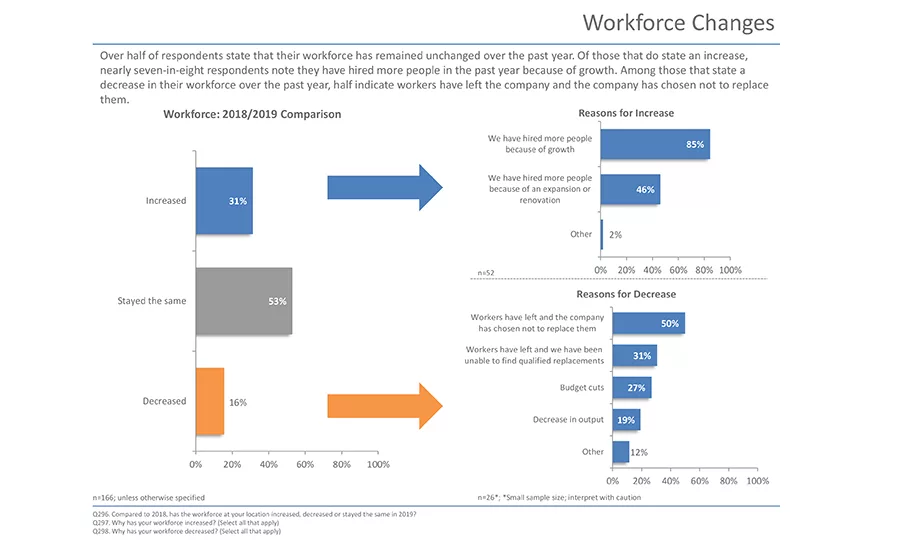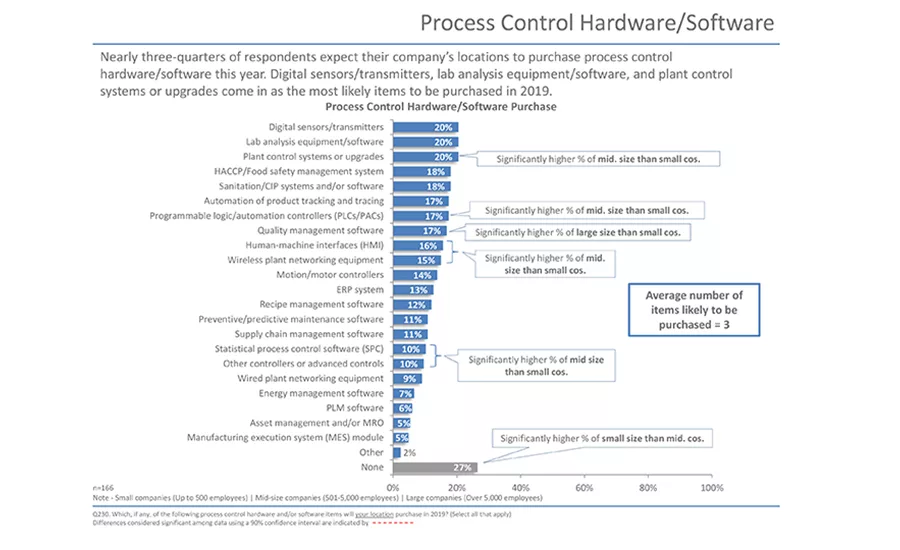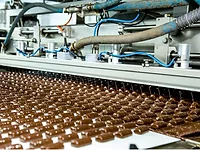The State of Food Manufacturing
2019 State of Food Manufacturing Survey
Food Engineering’s annual survey of the industry shows efficiency is top of mind for food and beverage processors

Food and beverage makers give much of their attention to improving efficiency on the line and automating on a budget, according to Food Engineering’s survey of industry leaders.
Photo courtesy of Getty Images

More than half of respondents say their workforce hasn’t changed. For respondents whose workforces have changed, hiring due to growth is the main reason.

More than half of respondents say their budget for production, processing and packaging equipment has increased this year.

Most respondents say their company will be purchasing process control hardware or software this year. This slide shows the breakdown of what processors expect their companies to buy.
Click here to see the 2020 State of Food Manufacturing report
Since 2014, respondents to Food Engineering’s annual State of Food Manufacturing survey have ranked automation as the No. 1 trend affecting the industry.
Until this year.
While automation is still a top-two trend, it has been overtaken by efficiency/maintenance/new equipment by this year’s respondents. A plurality (37%) of respondents say that efficiency/maintenance/new equipment is their top concern, while 30% list automation.
Article Index:
Those two choices are well clear of the rest of the field, with no other answer receiving more than 17% of responses. While automation moving out of the top spot may be a mildly surprising result, it’s still clear that it’s a major concern for processors. In addition to being the second-most common choice for the biggest challenge, it touches most of the other top trends in one way or another.
Consider these two responses on how automation is affecting the workforce. Respondents to the survey were granted anonymity to offer them the opportunity to speak freely about what they see as the top challenges facing their companies and the industry as a whole.
Respondent A: “Due to increasing cost of labor and increasing difficulty to find enough people to hire, automation is becoming more important. Much of the automation is also resulting in higher efficiencies as well.”
Respondent B: “As we move to more automation, our employee count will likely drop, but there will be need for a few more skilled employees who can work with the automation.”
In the first case, the processor is viewing automation as a way to shore up the workforce as labor costs and a shortage of qualified workers make filling positions harder. In the second case, the processor views it from the perspective that automation will lead to fewer positions to fill overall, but it will still require a higher skill level from the workforce.
This example is common in the responses to the survey. As you will see throughout, efficiency and automation are the foundation for most of the things that keep food processors awake at night, even if they’re approaching them from slightly different directions.
The Top 10
Even though the top two trends scored well above other challenges, the rest still represent a fairly significant percentage of respondents. The top 10 trends are:
1. Efficiency/maintenance/new equipment (37%).
2. Automation (30%).
3. Customer demand (17%). Changes in how consumers want their food to be packaged, prepared, sourced, delivered and available are all affecting how processors approach both new and existing products.
4. Clean label/healthy foods (16%). Although this could be considered hand-in-hand with customer demand, there’s a significant difference between a consumer who wants a frozen meal in a single-serving size and a consumer who wants that meal with no high fructose corn syrup or without a certain dye. Clean label/healthy foods trends are a multiplier for the degree of difficulty created by changing consumer demands, because they often create additional production challenges and costs to products.
5. Decline in workers/worker availability (15%). Speak to a processor from just about any company and the conversation will soon turn to difficulties in finding labor, both skilled and unskilled. Low unemployment, insufficient technical training infrastructure and cost pressures are all forcing processors to scramble to find and keep good workers. In addition, immigration issues (see Page 55) are adding new complexities to the employee equation.
6. Training/wage increases (11%). As a subset of finding and keeping good workers, higher wages and increased training costs are producing budgetary pain for processors. Food production—with some rare exceptions—is a low-margin business to begin with, and having to devote more money to labor and training costs forces processors to find budgetary flexibility.
7. Food safety/FSMA (8%). Food safety and FSMA aren’t new concerns, but how they’re being evaluated and enforced are. With FSMA fully online, the FDA has switched from an educational to an enforcement model, which means processors must ensure that their plans to stay in compliance are being implemented and followed correctly.
8. Packaging (8%). Packaging is always a big expense for processors, and changing consumer demand and the rise of e-commerce are affecting this area tremendously. Whether it’s redesigning packaging to accommodate new product sizes or portions, designing secondary or even tertiary packaging for e-commerce or using packaging to promote clean label initiatives, processors are having to consider more variables.
9. Cost-related (6%). A catch-all category that could arguably be part of any other response given. As you’ll see later on, costs for products are changing, and they’re changing for a number of reasons.
10. Sustainability/eco-friendly (5%). As with food safety, sustainability isn’t a new concern. But how it’s viewed and implemented is changing. Most processors have picked the low-hanging fruit, so they are having to figure out how to implement sustainability initiatives that don’t easily pencil out.
10 (tie). Tariffs (5%). Although a relatively small number of respondents chose tariffs as their top concern, they are affecting processors in a number of ways. As one processor put it: “Potential tariffs from China have made it so that we have to prepare for two possible scenarios — a 25% increase on cost of goods or sourcing ingredients from other countries.”
Changing consumer demands
While changing consumer demands are regularly listed as one of the top challenges, the recent trend of clean label challenges makes for an interesting set of results in this year’s survey. Respondents could choose up to two options as the trends that will be most impactful to food manufacturing over the next five years, so it can’t be said that consumer demands (17%) plus clean label (16%) would exceed automation (30%) as the second-most common trend mentioned. But both of those categories being as high as they are shows that they’re having a big effect on how processors are operating.
Consider one response from a respondent about changing consumer demands: “People wanting wedding cupcakes instead of traditional wedding cake.”
While that is a very specific concern for that respondent, it shows the effect that trends have. If cupcakes are the hot item instead of cakes, that changes how the finished product is made, what ingredients are needed and the quantity required.
In terms of larger trends, the traditional model of a family all sitting down together for dinner to eat the same thing is changing, says Kara Nielsen, vice president, trend insights, CCD Innovation.
“People really are starting to eat differently and more uniquely—that whole notion of ‘my personalized diet,’” says Nielsen. “I can see a mom having to buy what she eats to manage her weight, what her high school football player son needs to work out, what her vegan daughter needs to eat and what her husband eats when he returns from his business travel.”
That trend, as well as consumers wanting more convenient, grab-and-go food and beverage items, is forcing processors to change how they manufacture and package foods.
“People don’t even eat regular meals,” says Nielsen. “They’re more like feedings. They carry a ton of stuff on the go. That also means that when you are shopping, there’s not that one snack for your family. There are five different things.”
“People really are starting to eat differently and more uniquely—that whole notion of ‘my personalized diet.’”
– Kara Nielsen
In addition to that, natural and clean-label products are becoming more available in both stores and via e-commerce, which creates challenges for processors that want to serve both markets. A store such as Walmart wants one size and quantity, while Amazon might want another. A chain of health-food stores may want a third to differentiate from the big-box stores, which are moving more into the clean label, healthy and specialty diet markets.
“I was in a Walmart in metro Detroit this summer,” says Nielsen, “and they had the keto pancake mix and the high-protein waffle mix and all of these items that you might think are only in the natural channel in the middle of a Walmart in suburban Detroit.”
The changing cost of products
Meeting all of those different demands causes engineering challenges, but it creates cost challenges as well. We asked respondents how their total cost per product, materials cost per product and labor cost per product has changed.
Almost 40% of respondents say their total cost has increased, with a mean increase of 9%. Of those who say their total cost has increased, 59% say cost has increased from 1-5%, with 22% saying 6-10%, and 10% saying 11-15%.
When it comes to labor costs, 54% say it has increased compared to 2018. Of those whose labor costs have increased, 53% say 1-5%, 32% say 6-10%, and 10% say 11-15%. The mean increase is 8%.
As for material costs, 53% of respondents say they have increased, with a mean increase of 8%. More than half (55%) of those whose material costs have increased say they have increased by 1-5%, while 29% say 6-10%, and 5% say 11-15%.
Labor issues
To help get a sense of how labor shortages are affecting processors, we also asked a series of questions about current workforce levels and how processors are responding to the challenges of finding and keeping skilled labor.
As one respondent says, “Retaining and recruiting top talent across all sectors continues to be a challenge. Finding employees with the technical skills is especially difficult.”
More than half of respondents (53%) say their workforce is the same size now compared to last year. Almost a third (31%) say that workforce has increased, while 16% say it has decreased. Among those who say their workforce increased, 85% say it has done so because of growth.
That tracks with the responses to a question about whether gross throughput would increase. Almost two-thirds (65%) of respondents say that throughput has increased, which shows that companies are growing and hiring more people to help meet increased demand.
But that’s not the whole story when it comes to workforces. Although a relatively small percentage of respondents say their workforce has decreased, half of them say workers have left and the company has chosen not to replace them. Respondents could choose more than one answer, and 31% say workers have left and companies have been unable to find qualified replacements.
While a large majority of respondents say their workforce has stayed the same or increased, the next question—“Is your location at full staff or understaffed?” is revealing. Forty percent of respondents say their operations are understaffed. Two-thirds of those respondents say that overtime is being used to meet production demands while understaffed, and 42% of respondents say there have been changes in shifts or production schedules. About a quarter say more processes are being automated.
Training and wages are how most companies are trying to attract and keep talent. Almost half of respondents (49%) say they are doing more training, while 43% cite increased wages. Just more than a quarter (27%) say improvements in nonwage benefits, 20% say more investment in retention, and 16% say their companies are doing all of those things.
Forty percent of respondents say their operations are understaffed.
One respondent raised an issue that is surely top of mind for companies trying to hire in certain areas of the country where opioid addiction runs rampant or recreational drug use is common:
“Someone that can pass a drug test.”
Budgets and capital investments
For the most part, budgets are in good shape. More than half of respondents (52%) say their budget for production, packaging and processing equipment has increased, with 30% of those saying it went up by more than 25%. Another 40% of respondents say their budget stayed the same.
Budgets for automation and control hardware and software are flatter, with 62% of respondents saying their allotment is staying the same. A third of respondents say that budget is increasing, with a mean increase of 19%. The top three purchases of process control hardware and software are digital sensors/transmitters, lab analysis equipment/software, and plant control systems or upgrades, with each of those choices being mentioned by 20% of respondents. Close behind were HACCP/food safety management systems and sanitation/CIP systems and/or software, both of which were mentioned by 18% of respondents.
When it comes to structural changes at food processors over the last year, 17% of respondents reported no changes. But of those who did have changes, the three most common (with as many choices as were relevant allowed) were: changed a process, expanded/renovated/added capacity to existing plants, and added a new line, with 40% choosing each. Close behind was added manufacturing staff, at 37%.
Only 18% say they installed advanced automation systems, but that number was made up of significantly more midsize (501-5,000 employees) and large (more than 5,000 employees) companies. Respondents from large companies were also much more likely to report adding an energy management system.
Food safety strategies
Food safety is always a top-of-mind concern for processors, and FSMA’s change from an educational to an enforcement model is making it more important than ever to have food safety plans and procedures in place. Responses to which food safety methods are in use varied fairly widely, but the top five are all being used by at least two-thirds of respondents. The top five methods are:
- Food safety management system (75%)
- Food allergen controls (71%)
- Comprehensive staff training (69%)
- Lot level traceability (66%)
- Recall plan (66%)
A particularly noteworthy aspect of responses to the food safety methods question this year was a significant increase in respondents saying they use both case level traceability and item level traceability. Case level traceability went from 37% in 2018 to 43% this year, and item level traceability saw an even bigger jump, from 44% last year to 54% this year.
As for preventive controls, 28% of respondents say they have no difficulty managing them. But 26% of respondents say they have challenges with supply chain preventive controls, and 18% say the same for sanitation controls.
The big picture
From year to year, the major trends shaping food manufacturing haven’t changed as much as they’ve changed positions on the list of things that are creating challenges for processors. But what is clear is that between changing consumer demands, workforce challenges, regulatory and food safety requirements, and automation challenges, food processors have any number of things to worry about.
The good news is that even with all those challenges, throughputs and budgets are generally increasing, which shows that processors are figuring out how to meet those challenges and continue growing. That trend shows a market that still has a lot of promise even in the midst of challenges.
Clear Seas Research. 2019 Food Engineering State of the Food Manufacturing, August 2019.
Clear Seas Research is a full service, B-to-B market research company focused on making the complex clear. Custom research solutions include brand positioning, new product development, customer experiences and marketing effectiveness solutions. Clear Seas offers a broad portfolio of primary, syndicated research reports and powers the leading B-to-B panel for corporate researchers, myCLEARopinion Panel, in the architecture, engineering, construction, food, beverage, manufacturing, packaging and security industries. Learn more at clearseasresearch.com.
To learn more about the report and purchase:
https://www.clearseasresearch.com/product/2019-state-of-the-industry-food-manufacturing-copy-2/?r=5
Looking for a reprint of this article?
From high-res PDFs to custom plaques, order your copy today!






